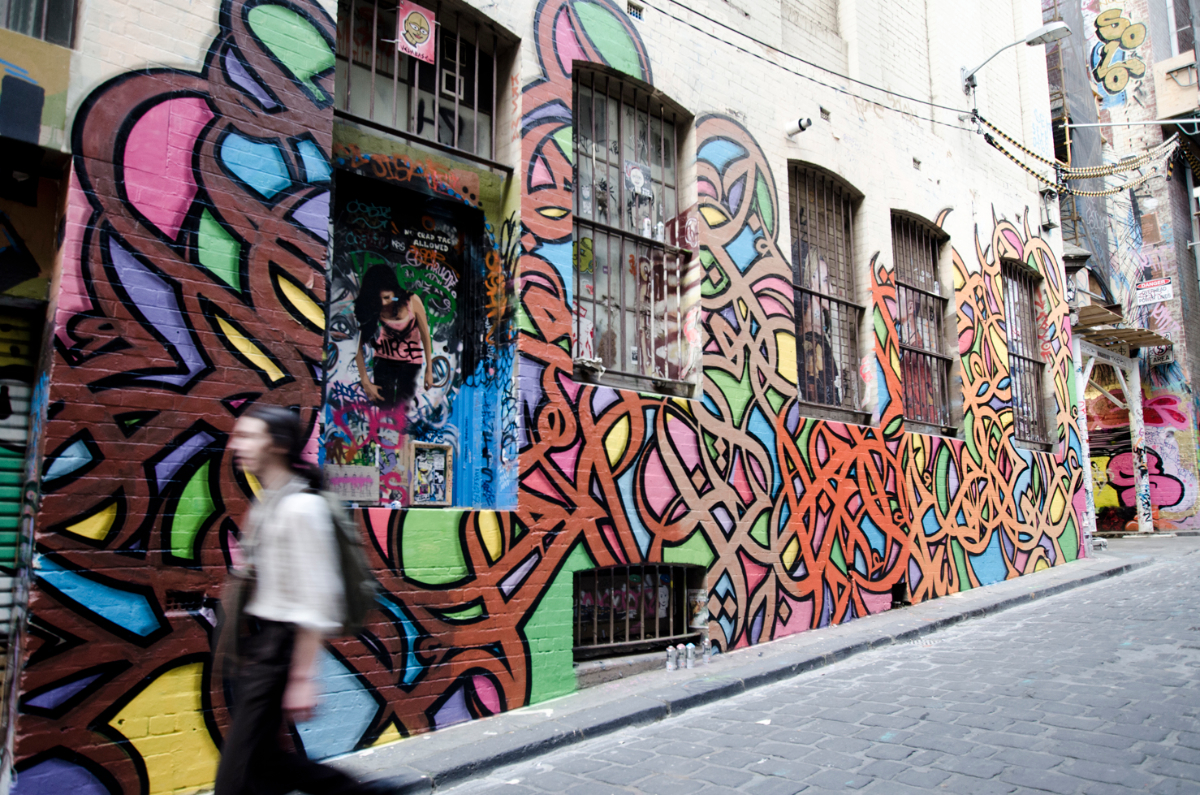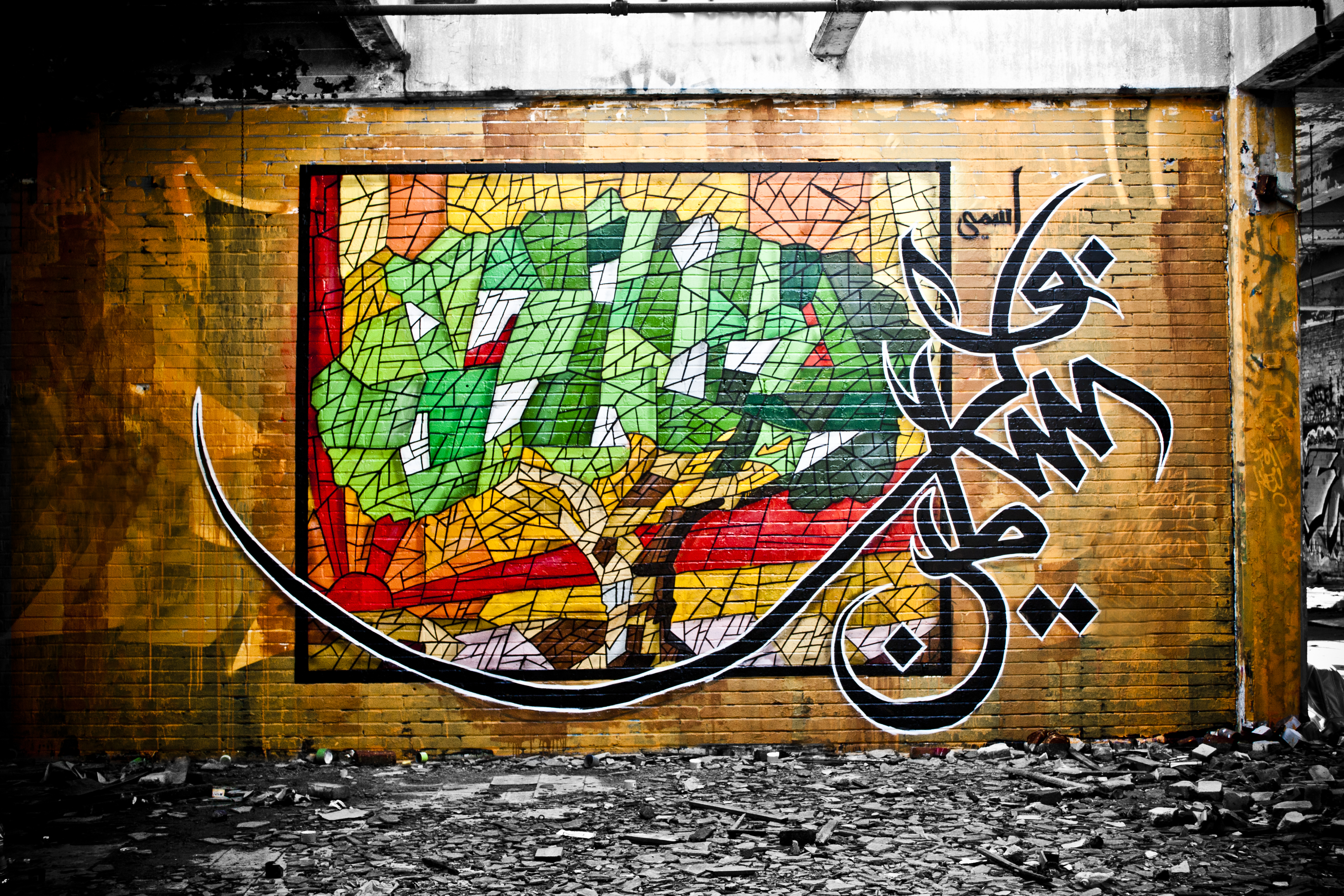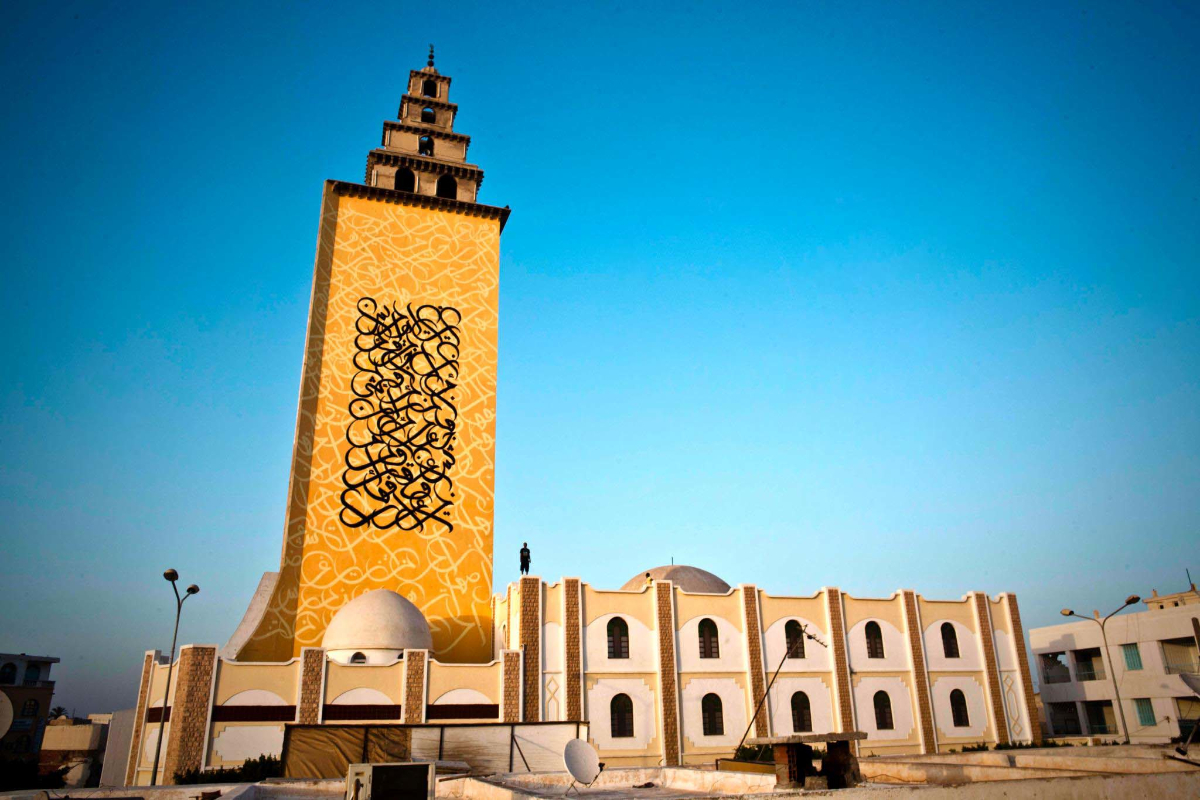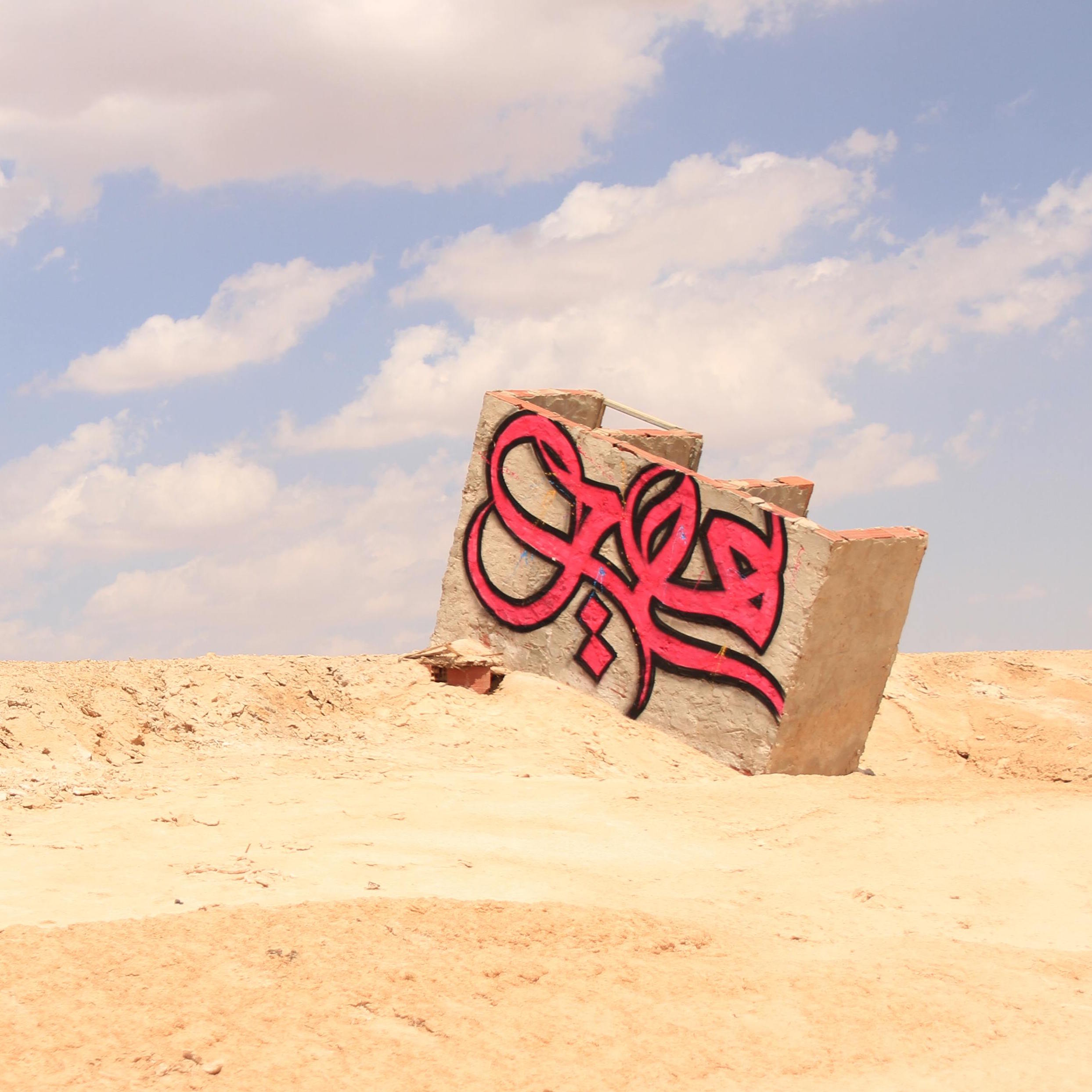Tunisia’s ‘master’ of calligraffiti on art, religion, and the power of spray paint
This August, Tunisian graffiti artist eL Seed unleashed his brand of ‘Calligraffiti’ - a term he uses in reference to his marriage of traditional Arabic calligraphy and modern graffiti - on Tunisia’s tallest minaret. To some, eL Seed’s recent project was an artistic triumph, and a brilliant synthesis of art and religion; to others, it was an act of sacrilege. I caught up with the man - whose name evokes the memory of Andalusia’s celebrated Spanish hero - to talk to him about his art, as well as recent developments in the burgeoning Tunisian art scene.
When did you begin working with graffiti? Why did you opt to pursue the path of a street artist, instead of, for instance, becoming a painter or photographer?
As a kid, I was brought up immersed in the Parisian Hip Hop scene, which included breakdancing, MCing, and of course, graffiti. I began ‘tagging’ in 1998, but never really took it seriously, as it was more of a hobby. Back then, my ‘thing’ was breakdancing, and I had a strong passion for cartoon sketching and calligraphy, although I could never find a proper teacher.
Street art has always been present in my life, and although I made some radically different life choices in my early twenties, I got back into graffiti a few years later. I always tell people that it’s something that chose me. I wasn’t necessarily conscious of the choice to become a street artist, because it happened so naturally; it was as if it was already in my blood. Now that I am able to practice my art full time, I am exposed to many more art forms that I’m now able to experiment with and mix into my Calligraffiti. This mainly includes photography and film, and who knows – I may add those to my repertoire somewhere down the line!
Who are your artistic influences? Your work is quite unique in the fact that it is street art – a relatively untraditional art form – yet, at the same time, it features traditional aesthetics and motifs of Arabic calligraphy.
The one artist who really helped shape my artistic path is the French graffiti artist Hest1. His style is very unique, and although he doesn’t paint in the Arabic script, his letters are ‘arabesque’. He coached me during my time in North America, and while painting together, it was only natural that his years of experience ‘rubbed off’ on my less-mature style.
In the beginning, my creations were quite minimal, and I would simply ‘tag’ my street name, eL Seed. It was only after deeper reflection, countless conversations, and painting more and more frequently that I started developing my artistic philosophy. Key words started appearing in my discourse, and I started to explore my own sense of identity, which has underpinned most of my work since.

Having been born to immigrant parents, the pull between my cultural homeland and my actual one was powerful. For me, this was felt strongly in the mix between cultural traditions emanating from my family in southern Tunisia (where I spent many months each year), and the very different reality in Paris. Discrimination was a big part of my life growing up, and I inevitably romanticised my roots in an effort to belong. I think the more I understood these different dichotomies on an intellectual level, the more it became visible in my art as it matured, and I tried to merge these supposedly different themes together.
How is street art perceived in Tunisia? What has been the public’s reaction to your works thus far?
Things have become more complicated in Tunisia since the revolts against [former President] Ben Ali. Before, the arts scene was just another regular underground scene that didn’t get much spotlight. Now, it has become something quite visible in most parts of Tunisia. Just the fact that people took up cans of spray paint and paint brushes, writing their thoughts on walls across the country, brought street art/writing to the forefront of critical expression.
It was only after deeper reflection, countless conversations, and painting more and more frequently that I started developing my artistic philosophy
As in most places, Tunisians have mixed reactions to street art, which includes my own personal work. So far, the reactions have been overwhelmingly positive and supportive. The latest three walls I painted in Tunis and Kairouan brought together many people in a really organic way, and I was even given permission to paint a wall through a random encounter in a café. From these experiences, I would say that people are excited by the prospect of seeing more of this type of art, and it is something that is growing in the hearts of the Tunisian youth.

We keep hearing about the role street art has played in the recent upheavals in the Arab world. What role did it play in the Tunisian revolts, and to what extent is it acting as a catalyst for change today? What part do you see yourself playing in all of this?
This would really depend on your definition of ‘street art’. Does this include writing? If so, then it played a huge role, as street walls provided the necessary canvas for people to assert themselves in public spaces. I think this type of writing can serve as an opening into a more artistic form of expression with spray paint. Some younger folks I spoke to told me they became addicted to the ‘feeling’ of the spray can, and wanted to go beyond just writing, to create something more complex. This is one way in which street art has been a catalyst for change. Some have found their passion, and have created a niche in the visible Tunisian art scene, which has brought about bigger and bigger artistic and cultural projects to different towns across the country.
As for myself, I hope to contribute to this growing phenomenon, and give a hand to any aspiring street artists. I find it extremely inspirational to find people from all backgrounds and beliefs uniting thanks to art, and the love of graffiti. What I hope for, is that artists now and in the future will be able to express their individual identity though their art, and not simply copy North American forms of writing. This could mean something incredibly powerful in terms of citizen engagement, participatory democracy, and the advancement of Tunisian society.
How do you view the recent Salafist protests against the artworks shown at the Printemps des Arts exhibition in Tunis? What is the artistic climate in Tunis like these days?
There is a very big misconception – both nationally, and internationally – that art, culture, and religion are either in opposition, or aren’t connected. It has become somewhat of a polemic here in Tunisia since the Printemps des Arts and the Persepolis (Iranian-French director Marjane Satrapi’s animated film which was banned in Tunisia) fiasco, among other incidents. Since then, the media has made it seem as though these marginal anti-social groups creating havoc are mainstream, when in fact, they are not.

There are no tensions in a general sense between religious sects and the art community. I have, however, observed a desire among certain people within the art community to create tension and provocation in a superficial manner, whilst hiding beneath the guise of ‘subversive art’. We have to stop feeding this false polemic, and start digging deeper into the problems that actually exist in our social fabric – as artists, practicing religious folks, atheists – whatever one’s chosen label.
What is the story behind your pseudonym? Am I wrong in believing it to be a reference to the famous El Cid?
When I started doing graffiti in the late 90s, I was studying the book Le Cid de Corneille in French class. The professor was saying that the word ‘Cid’ came from the Arabic ‘El Sayed’, which in English translates to ‘the master’. I was 16 years old at the time, and said to myself, ‘I am the master!’ That’s why I chose the name.
What was the reason behind painting the mural on the minaret? How has this work been received by Tunisians? Already, critics seem to be divided on the piece, with some calling it art, and others deeming it sacrilegious.
The primary purpose was, and is, to inspire people to get together and positively engage in community building. The project came about right after the clash we witnessed at the Printemps show, and I wanted to encourage and portray the exact opposite of what happened. Both sides of the minaret are painted with a verse from the Quran, which encourages tolerance, dialogue, and curiosity of ‘the other’, which reads:
Oh humankind, we have created you from a male and a female, and made people and tribes so you may know each other (Surah 49, Verse 13).
As well, recent tensions in Tunisia have sparked a critical debate about the limits of artistic freedom in the birthplace of the Arab Spring, as it has undergone a nascent transition to democracy. This project was not about decorating a mosque; it was about making art a visible actor in the process of cultural and political change. I truly believe that art can bring about fruitful debate, especially within the uncertain political climate we’re experiencing now in Tunisia.
The minaret was completed on August 17th. Now, as a community, we have to complete it by finishing the rest of the base paint around both murals, as well as installing windows. Once this is done, the entire mosque will be finished – quite a few years after its initial ‘completion’!

